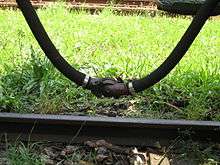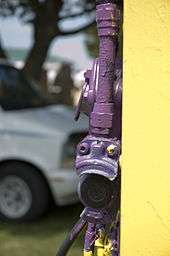Gladhand connector


A gladhand connector or gladhand coupler is an interlocking hose coupling fitted to hoses supplying pressurized air from a tractor unit to air brakes on a semi-trailer,[1] or from a locomotive to railway air brakes on railroad cars.[2] Gladhand connectors resemble a pair of "hands shaking" when interlocked, hence the name.[1]
Design
Gladhands are designed to allow the driver to disconnect without a mechanic or tools.[1] They sometimes utilize a quick release style to speed up brake release time.[1] A tractor / trailer typically has two gladhands - one for service brakes and another for emergency brakes.[3] Gladhands are color coded; service lines are blue and emergency brake lines are red.[3]
Mated rubber grommets provide a positive seal.[4] Joined halves separate automatically when depressurized. Gladhand couplers are typically genderless or hermaphroditic,[1] allowing them to be freely connected to each other, for example allowing either end of a railcar to be connected to the end of a train. North America has a system of standardized gladhand sizes.[1]
References
- 1 2 3 4 5 6 Bennett, Sean (2007). Modern diesel technology: brakes, suspension, and steering. Clifton Park, NY: Thomson Delmar Learning. p. 54. ISBN 1418013722. Retrieved December 12, 2015.
- ↑ Pitt, John (2012). USA by rail : plus Canada's main routes (8th ed.). Chalfont St. Peter: Bradt Travel Guides. p. 29. ISBN 184162389X.
- 1 2 Byrnes, Mike; Publishers, Associates, Inc. (2003). Bumper to bumper : the complete guide to tractor-trailer operations. (4th ed.). Corpus Christi, TX: Mike Byrnes and Associates. p. 165. ISBN 0962168769. Retrieved December 12, 2015.
- ↑ Knapp, Gordon J. (2011). Is Over the Road Trucking for You? (Second ed.). AuthorHouse. p. 193. ISBN 1463403321. Retrieved December 12, 2015.